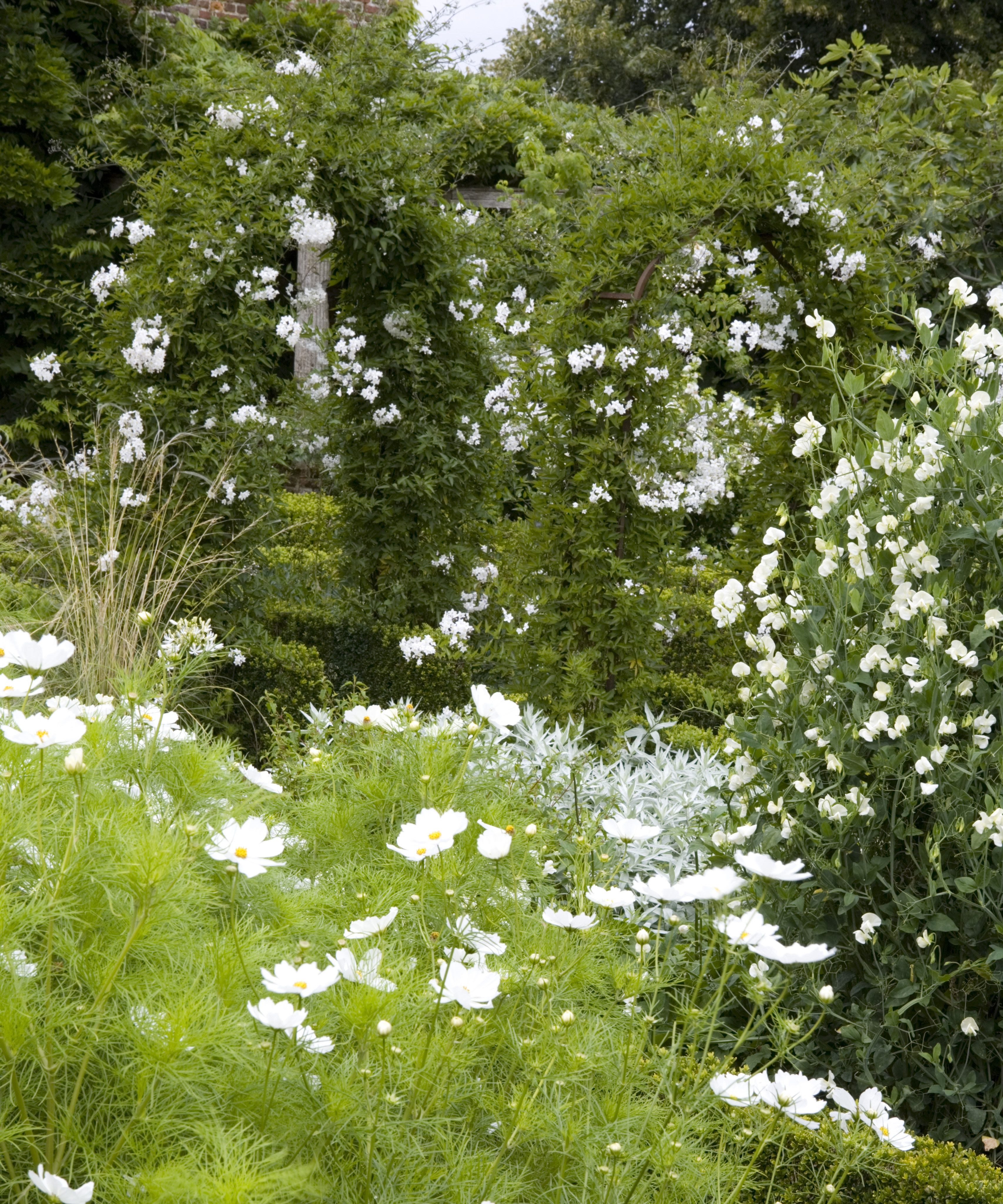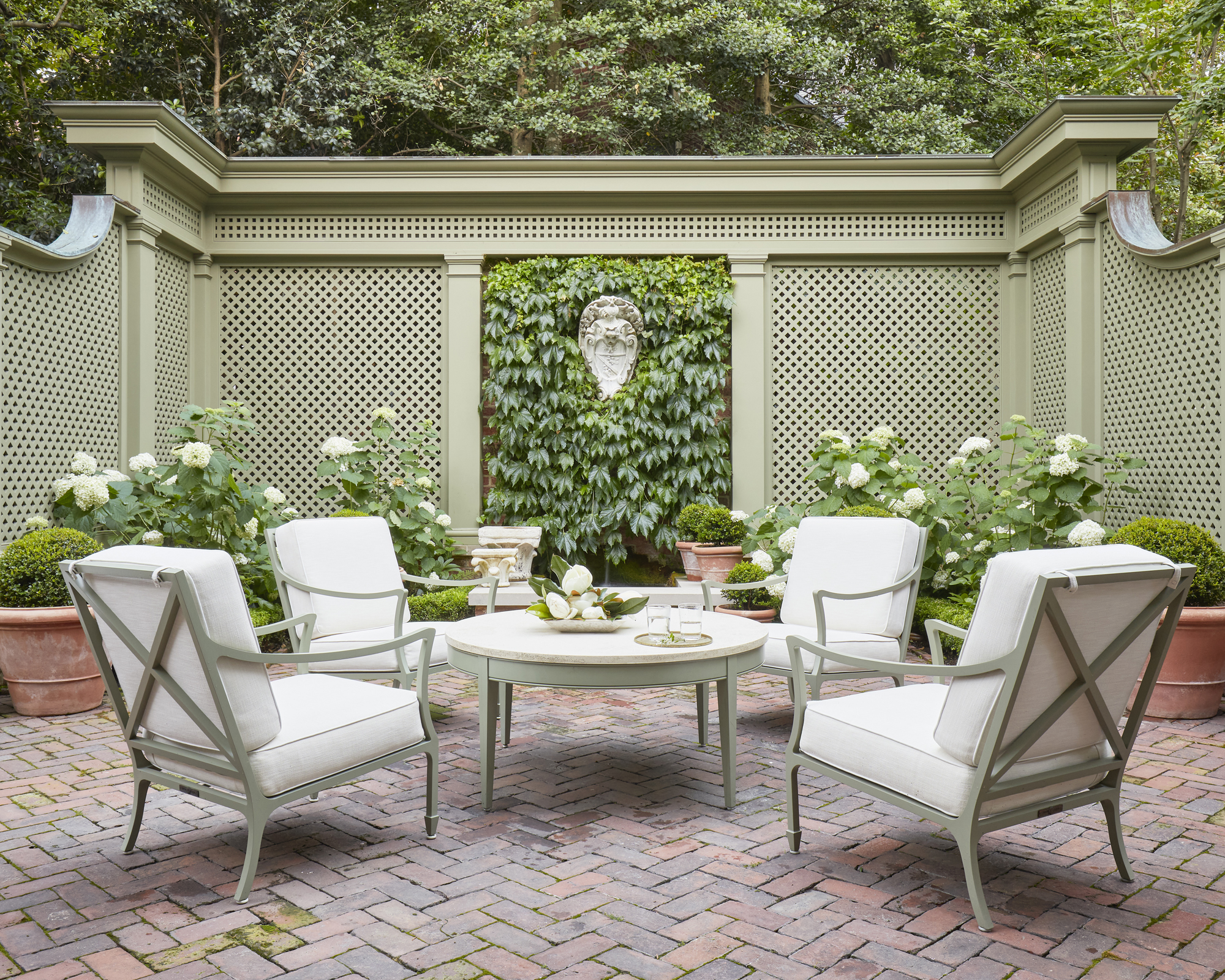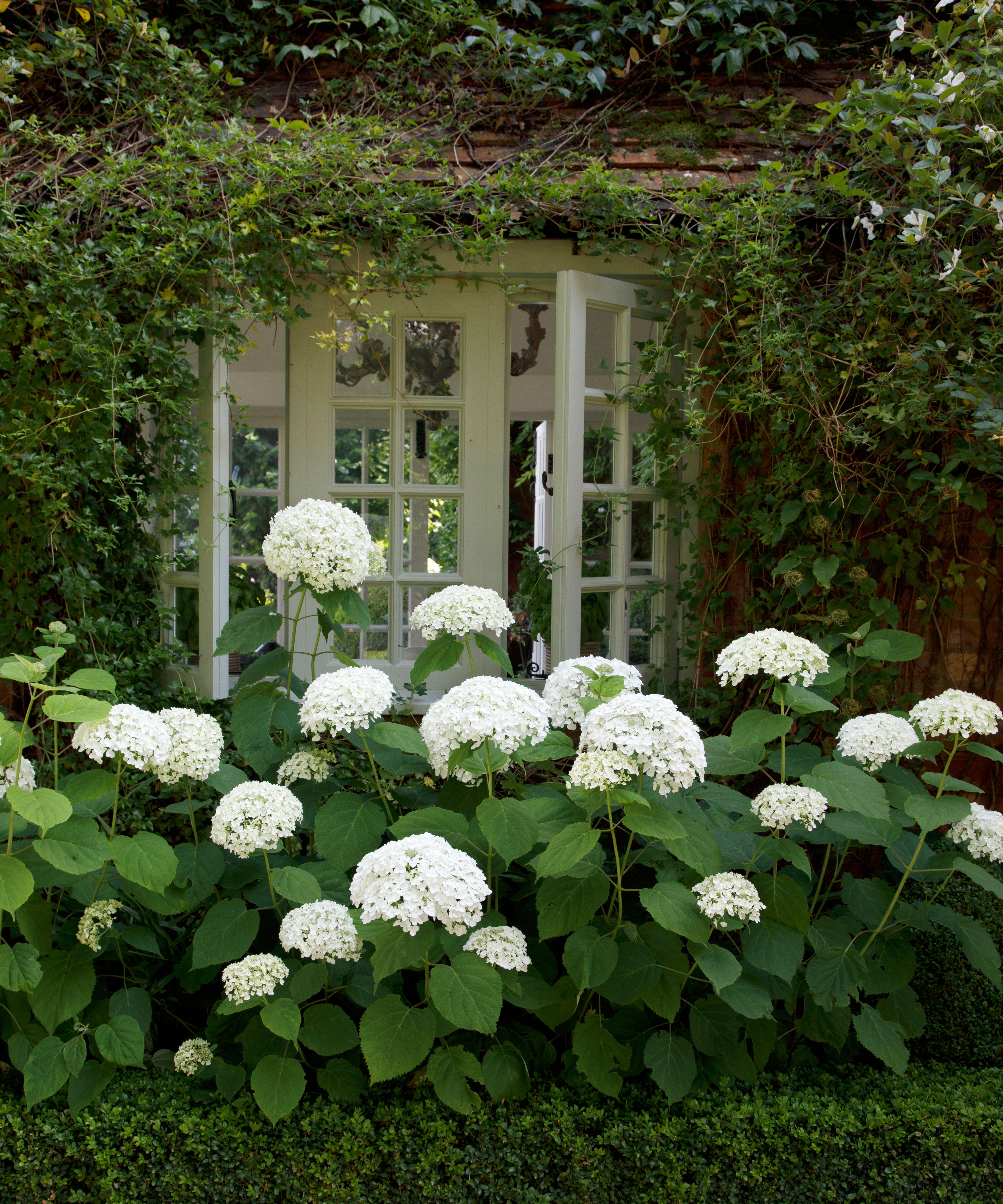White garden ideas – 10 elegant designs full of shape and texture
Make a dazzling design statement with these white garden ideas for an elegant yet bold planting scheme


With these white garden ideas you can see what possibilities a monochromatic scheme can offer.
In reality, a white garden is never just white, but includes myriad tones of greens and grey foliage, and various 'shades' of white flowers – from pale yellow, ivory, cream, oyster white, greenish white, bluish white, to the very palest blue.
You can create calming, serene and elegant spaces by including only white blooms as part of your garden ideas, for timeless designs that will work with both contemporary and traditional yards.
A white garden is definitely an option that should be added to the mix when you're deciding on a garden color scheme, and is particularly suited to a formal garden design.
'White stands out and yet goes with anything. Think of white flowers against green foliage: the flowers show themselves clearly yet work in harmony with the leaves, taking on elements of the green which surrounds them,' explains garden designer Jo Thompson in her new book The Gardener’s Palette: Creating Colour Harmony in the Garden.
White garden ideas

There are many elements to consider when planning a white garden, from the types of flowers to include in your flower bed ideas, to how to create year round structure with evergreen shrubs and ensuring a long season of interest from blooms.
A white scheme can be particularly impactful as a small garden idea, or for narrow gardens, where the self illuminating and reflective qualities of the white flowers can help to lift dark areas.
Design expertise in your inbox – from inspiring decorating ideas and beautiful celebrity homes to practical gardening advice and shopping round-ups.
1. Plan a strong layout

A strong layout is key to the design of a white garden.
Troy Scott-Smith is head gardener at the world renowned Sissinghurst Castle Garden designed in the 1930s by novelist and poet Vita Sackville-West .‘At Sissinghurst, the white garden is quite formal in essence, the structural layout a series of paths and small box hedges on a grid pattern and that really holds the garden all through the year, regardless of the season and whether there are lots of white flowers in bloom,’ explains Troy.
White blooms provide the infill for to the evergreen borders in the parterre garden of this inspiring garden to visit.
'Structural hedging, including yew, Taxus baccata, provides an evergreen frame and will “show off” whites,’ agrees garden designer Claudia de Yong.
Consider including topiary to provide form and contrast to white blooms.
2. Contrast texture and form

Avoid monotony in a white garden by varying plant height and shape.
‘Spires of tall flowers add impact; those with blousy blooms, such as peonies, Paeonia lactiflora ‘Duchesse de Nemours’, add weight. Plant the same varieties in large groups, repeating the combination,’ advises garden designer Claudia De Yong.
‘We have a combination of three types of plants at Sissinghurst. Lots of mound forming grey leafed plants, such as artemisia and Eryngium giganteum Miss Willmott’s Ghost, through which there can be spires of elegant delphiniums, lupins, verbascum and white foxgloves, and then as a further contrast, wispy and ephemeral flowers like gypsum and poppies,’ adds Troy.
Many white cottage garden plants work well in a white garden scheme.
3. Densely plant

In a white garden, plant flowers densely for greater impact.
‘Vita said “cram, cram, cram” and that is not a bad philosophy in a white garden sense. Two of our most successful beds this year are because there is no sense of soil,' explains Troy.
'All plants need to be harmonising and not competing, but to create impact be generous. Celebrate one beautiful specimen plant, or a selection that naturally sits cheek by jowl; a "fruit salad" planting effect is not always so pleasing,' Troy adds.
Learn how to plant a flower bed and carefully plan your choices.
'There is always a rhythm to our crammed beds, with keynote plants that are repeated throughout so there is something for the eye to settle on as you are scanning across. A useful trick is to take a photo and put it into monochrome so you can see how the shapes work, because shape is everything in a white border,’ says Troy.
'In terms of layering or grouping, it’s quite important that you have a degree of contrast, but not so much of it that it becomes distracting or confusing,' adds garden designer Dan Pearson.
4. Create a mood

‘I would use whites for creating a design that feels clean, uncomplicated and calming; planting the likes of cow parsley and clean whites, rather than whites with pink in them. Or I would use whites that are geared towards cream and yellows. This will keep things calm and uncomplicated,’ says Dan Pearson.
To add to a sensory garden experience, include plants for pollinators so that visiting wildlife and the buzz of insects adds an extra dimension to your yard calming and soothing space.
'The emotion white conjures up can be tipped from cold to warm, just by the slightest addition of another color,' explains Jo Thompson.
'White is white because it reflects all colors: white objects absorb no wavelengths.'
5. Use foliage

‘Foliage plants are a vital ingredient in a white garden, so use evergreen topiary and dark leaf flowering shrubs, such as the smoke bush, Cotinus coggygria ‘Royal Purple’ for contrast,' explains Claudia de Yong.
'Include white, silver, variegated and dark leaved plants in your mix, which add to the appearance of abundant blooms. Trees, such as the pale soft green of the weeping pear, Pyrus salicifolia ‘Pendula’, blends perfectly with white planting,’ says Claudia.
'Some are disinclined to use variegated foliage, but I shall continue to defend it vigorously. In a dark corner, variegated evergreen Euonymus fortunei ‘Silver Queen’ performs brilliantly, almost lighting up the space and behaving however you want it to behave, whether that be keeping it in a mound or letting it scramble through its neighbors or up against a wall, which it loves to do,' says Jo Thompson.
The best shrubs for shade include include those with variegated and interestingly textured foliage.
'Vita called it the grey, green and white garden at Sissinghurst – never the white garden – as there is a large quantity of grey leafed plants, which is really helpful rather than just green foliage,' says Troy.
6. Work with walls

Use vertical planting ideas in a white garden to great effect.
‘Add a bit of drama by planting the tall spires and heads of Lilium regale ‘Album’ which look great against brickwork. Don’t forget to include flowering climbers, such as the scented evergreen climber Trachelospermum jasminoides, Wisteria floribunda f. alba, varieties of clematis to grow, such as ‘Duchess of Edinburgh’ and roses like ‘Madame Alfred Carrière’, which has the advantage of flowering on a north facing wall or fence,’ explains Claudia.
Make sure you know how to prune climbing roses and how to prune clematis to keep them blooming well.
7. Plan a long season of interest

Stagger blooms for a long season of interest.
‘We start off early planting spring bulbs narcissus and tulips coming through an understory of grey leafed plants. But we might also have repeat sowings of plants, such as Ammi majus with its lovely airy umbels, which we sow in September to flower at end of March/April, but also sow some in February so there is no gap, and we have continuum made by two or three successive sowings.
These sit beside more permanent and enduring repeat-flowering roses planted for rose garden ideas, such as R. ‘Penelope', and include late summer flowers.
'So it's important to plan ahead and think abut successive sowings and the shape of things you want to create,' adds Troy.
‘Don’t forget to look at ground cover plants, as well as evergreen shrubs, many of which flower in the winter months, such as Myrtus communis, Osmanthus delavayi and Sarcococca hookeriana,’ adds Claudia.
Include as many annuals in your planting as you can, such Cosmos bipinnatus ‘Sonata White’ and Nigella ‘ Miss Jekyll White’, biennials such as Digitalis purpurea ‘Albiflora’, and tender perennials like Nicotiana sylvestris, which will flower in light shade,' Claudia adds.
8. Mix whites

'We speak of not mixing creamy white and white, but I find that as long as there is a contrast of foliage, mixing the two can work well,' explains Jo Thompson.
'For instance Rosa Macmillan Nurse = ‘Beamac’ alongside Cornus kousa and Viburnum opulus. The rose’s dark green leaves act as a foil, separating it just enough from its white-flowering neighbors; otherwise their shades of white could look a little “off ” against its creamy blooms, which have just a hint of a faded pink.'
Along with the varying 'shades' of white flowers to include in a white garden, consider that some flowers have yellow centers, like daisy flowers, 'which might be acceptable or you might not want it. Quite often white flowers have red leafed stalks, such as gallinea – which produces lovely flowers like a swarm of hovering white flies – but has a pronounced red calyx, so you either accept it, or cut it all down and do without the feature later in year,' adds Troy.
9. Plant around seating areas

‘White flowers are self illuminating so are ideal planted by an outdoor dining area where they will shine in a dusky setting,’ explains Troy Scott-Smith.
'The white garden was deliberately planted where it was at Sissinghurst because it was near the dining and kitchen areas, so they could sit out and there would be some natural reflection from the white blooms as dusk encroached,' he adds.
White gardens work well around patio ideas, and for added delights include white fragrant flowers, such as fragrant roses, and night-scented plants. 'Night scented stock is really incredible, so they are nice to introduce,' adds Troy.
10. Choose flowers for shade and sun

Bright sunlight can look a little harsh on some white flowers, and can make white become uncomfortable visually. 'But a lot of white flowers come from grey leafed plants, which need to sun, so you need to understand how to sunlight travels around your garden, where are the areas of full sun, and those in dappled light and shade when you are choosing your palette of flowers, ' explains Troy.
Hydrangea arboresens 'Annabelle', for example, has creamy white blooms that cope well in full sun to partial shade, whereas other options for a white garden may suffer in the full glare of the sun.
How do I make my garden white?
You can make your garden white by planning your planting to include a range of white flowers that bloom at different times of the year, and include a variety of texture, height and form.
'White flowers can be over quite quickly, so require a lot of maintenance and intervention, deadheading and tidying as they can go brown. You will have to remove the ageing heads of white flowers that are quite ephemeral and fleeting, otherwise it can make your white garden look quite rough and messy,' warns Troy.
How do I make a white border in my garden?
To make a white border in your garden, mix a combination of white flowering plants of varying heights and forms that work well together.
Claudia de Yong suggests the following planting combinations of shade plants for shady spots, including:
- Dicentra spectabilis ‘Alba’
- Astrantia major ‘Large White’
- Digitalis purpurea ‘Alba’
- Galanthus
- Hosta ‘Fire and Ice’
- Helleborus ‘Niger'
- Hydrangea aborescens 'Annabelle’
- Aquilegia vulgaris 'Nivea'
- Anemone x hybrida ‘Honorine Jobert’
For sunny spot, Claudia recommends a combination including:
- Agapanthus africanus ‘Albus’
- Anemone Wild Swan
- Lychnis coronaria ‘Alba’
- Dianthus ‘Mrs Sinkins’
- Allium stipitatum ‘Mount Everest'
- Echinacea purpurea ‘White Swan’
- Penstemon ‘White Bedder’
- Cistus x hybridus
- Centranthus ruber ‘Albus’
Rachel is senior content editor, and writes gardening content for homesandgardens.com, Homes & Gardens magazine, and its sister titles Period Living Magazine and Country Homes & Interiors. She has written for lifestyle magazines for many years, with a particular focus on gardening, historic houses and arts and crafts, but started out her journalism career in BBC radio, where she enjoyed reporting on and writing programme scripts for all manner of stories. Rachel then moved into regional lifestyle magazines, where the topics she wrote about, and people she interviewed, were as varied and eclectic as they were on radio. Always harboring a passion for homes and gardens, she jumped at the opportunity to work on The English Home and The English Garden magazines for a number of years, before joining the Period Living team.
